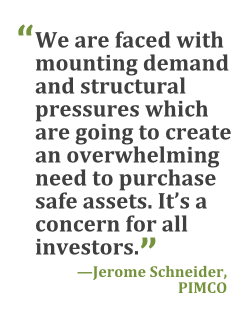Just because the Federal Reserve is about to raise interest rates, don't expect savers to benefit.
Over the past six years, it's been practically impossible for depositors and investors in money-market funds to keep up with the cost of living as the Fed slashed rates close to zero in an unprecedented bid to restore the U.S. economy.
Now, savers counting on higher rates to lift returns are being stymied by regulations designed to make the financial system safer. The rules are pushing firms to park more excess cash into Treasury bills that yield next to nothing, squeezing money-market funds that buy the short-term debt. JPMorgan Chase & Co. says demand will jump as much as US$900 billion in the next 18 months, equal to about 60 percent of the total outstanding.
 “You've got the worst of all possible worlds for savers,” especially as inflation picks up, Christopher Sullivan, who oversees $2.4 billion as the chief investment officer at United Nations Federal Credit Union, said from New York.
“You've got the worst of all possible worlds for savers,” especially as inflation picks up, Christopher Sullivan, who oversees $2.4 billion as the chief investment officer at United Nations Federal Credit Union, said from New York.
The squeeze reflects yet another unintended consequence of regulators' moves to limit risk-taking among financial firms in the wake of the credit crisis, which have already dried up liquidity in debt markets and encouraged investors to hoard.
It also suggests that savers, particularly the 76 million baby boomers who are nearing retirement, may be deprived of much-needed income long after the Fed starts to boost rates.
Higher capital requirements mandated by the Basel Committee on Banking Supervision, which went into effect in January, have made holding certain types of cash so costly some banks are adding fees to dissuade depositors.
JPMorgan Chase, the largest U.S. bank, will charge hedge funds and other institutions on deposits that aren't immediately required for business as the New York-based lender tries to shed $100 billion of deposits, chief financial officer Marianne Lake said Feb. 24 in a presentation to investors.
That cash is likely to wind up in Treasury bills and may push rates on some of the short-term debt below zero, said Tyler Tucci, a U.S. government-bond strategist at Royal Bank of Scotland Group Plc's RBS unit in Stamford, Connecticut.
U.S. debt due in a year or less yielded 0.05 percent on Friday, index data compiled by Bank of America Corp. show.
“If all this institutional cash is allocated to Treasury bills, we could potentially get our first look at a sustained move into negative territory,” he said.
Diminishing Returns
That threatens to further depress returns in the $2.6 trillion money-market fund industry, which holds a sizable chunk of the ultra-safe securities.
Average yields for the biggest funds haven't topped 0.1 percent since 2010, according to money-market researcher Crane Data LLC. Before 2008, they were closer to 5 percent.
Tougher regulations in the market-market industry that start in 2016 are also prompting some providers to convert higher-yielding funds into government-only investments.
Fidelity Investments said in February that its Fidelity Cash Reserves Fund, the largest of its kind with more than $100 billion, will stop buying short-term debt issued by companies and transfer assets to government securities.
At the same time, the U.S. bill market itself will shrink $155 billion during the second quarter as the U.S. issues just enough debt to meet redemptions, according to Citigroup Inc.
“We are faced with mounting demand and structural pressures which are going to create an overwhelming need to purchase safe assets,” Jerome Schneider, the head of short-term strategies and money markets at Pacific Investment Management Co., which oversees $1.68 trillion, said from Newport Beach, California. “It's a concern for all investors.”
David Rosenberg, the chief economist at Gluskin Sheff & Associates in Toronto, says higher rates will ease some of the pain that savers have endured as a result of the Fed's extraordinary stimulus over the past six years.
Traders are pricing in a 59 percent chance the central bank will start raising its rate in September, while derivative markets indicate it will peak at about 2.36 percent by December 2018. Rosenberg predicts the Fed will wait until next year and then lift funding costs more aggressively.
“The era of financial repression for ultra risk-averse investors is drawing to a close,” he said. “Savers will ultimately have their day. It's only a matter of time.”
Rates on 12-month bills climbed to 0.26 percent on Monday, the highest in four years, after a stronger-than-expected jobs report strengthened the case for the Fed to lift rates.
Living Costs
The rate was at 0.24 percent as of 11:55 a.m. in New York.
Higher short-term rates on Treasuries may still not be enough to compensate savers if the U.S. economy produces the kind of growth that spurs faster cost-of-living increases.
While 12-month bill rates will climb to 1.2 percent in a year's time, according to the forwards market, the problem is that inflation may accelerate just as much, averaging 1.19 percent over the coming year, based on swaps trading.
Negative yields on debt in a dozen developed nations, including Germany and Japan, will also lure bond buyers to the U.S. and contain any selloff in Treasuries.
“There is more cash that is seeking a home in high-quality short-term assets,” Andrew Hollenhorst, a fixed-income strategist at Citigroup, said from New York.
© 2025 ALM Global, LLC, All Rights Reserved. Request academic re-use from www.copyright.com. All other uses, submit a request to [email protected]. For more information visit Asset & Logo Licensing.




